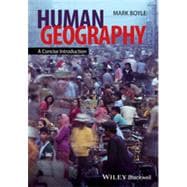- Introduces and applies the basic concepts of human geography in clear, concise, and engaging prose
- Explores the significance of the rise, reign, and faltering of the West from around the fifteenth century in the shaping of the key demographic, environmental, social, economic, political, and cultural processes active in the world today
- Addresses important thinkers, debates, and theories in an accessible manner with a focus on discerning the inherent Western bias in human geographical ideas
- Incorporates case studies that explore human geographies which are being made in both Western and non Western regions, including Latin America, Africa and Asia.
- Is written so as to be accessible to students and contains chapter learning objectives, checklists of key ideas, chapter essay questions, zoom in boxes, guidance for further reading and a book glossary.
- Accompanied by a website at www.wiley.com/go/boyle featuring, for students, tutorial exercises, bonus zoom in boxes, links to further learning resources and biographies of key thinkers, and for instructors, further essay questions, multiple choice exam questions, and ppt lecture slides for each chapter.








